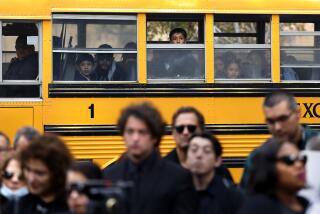The Age of Denial : Those Boom Theories May Really Be Busts
- Share via
The biggest generation in American history is not the baby boom, but rather what many call the baby bust.
That, at least, is the against-the-grain contention of two historians who wrote two well-respected works on American generations, “Generations” (Quill, 1991) and “13 Gen” (Vintage, 1993). Boomers Neil Howe and Bill Strauss will argue till facial blueness that this is the case--even against a tide of inconsistent media generalizations about these generations.
Their argument goes something like this: The baby boom was a fertility trend. Births did indeed explode in the years 1946 through 1964. The baby bust was also a fertility trend. Births did indeed recede in the years 1965 through 1976. But fertility trends do not a generation make.
Howe and Strauss’ definition of a generation--one that is also often used in sociology and anthropology--is a roughly 20-year span of history in which a group of people grows from birth to adulthood. This group has parents the same or similar ages and, most importantly, shares a common culture. That would rule out an 11-year “baby bust generation,” and it could call into question the commonly held baby boom years.
Diane Crispell, executive editor of American Demographics magazine, takes credit for some of the designations that Howe and Strauss so vehemently dispute.
“I established the baby bust,” she says. “Those are folks born ’65 to ’76. My justification for that is that in the late ‘70s, births started to rise again, and the people having the children were boomers. It’s a birth cohort.
“ ‘Generation’ is a convenient way to group the population, but it’s not etched in stone,” says the 36-year-old executive editor.
Howe and Strauss argue that the baby boom--as a generation, not as a fertility trend--actually started in 1943 and ended in 1960. They say people born in ’43 share the same history as boomers, identify with being boomers and constituted the cutting edge of boomer trends (protesting, long hair, having babies in the ‘80s). That would, presto, make Newt Gingrich a boomer. That would also cancel the frenzy over boomers turning 50 since, according to these guys, they started turning 50 three years ago.
“If you ask people who are born in ’43 or ’44 whether they consider themselves boomers, they will say an emphatic ‘yes,’ ” Strauss says. “One of the key binding qualities of boomers born in ’43 is that being born in that new year meant you could not easily glide out of the Vietnam draft with deferments anymore,” he says.
On the young end, Howe and Strauss call the next generation, often referred to as the baby bust or Generation X, “13th Gen,” because they say it is the 13th in American history. They give the next generation the birth years ’61 through ’81.
Although the boom in fertility continued through ‘64, the duo argues that those born in the years ’61 through ’64 do not identify with boomers and represent the cutting edge of trends (slacking off, postponing family life) attributed to the next generation. That would make Douglas Coupland--the author who titled his book “Generation X” (St. Martin’s Press, 1991) to give a name to early ‘60s babies--a “13er,” not a boomer.
They stop the 13th generation in 1981 because that’s about the time boomers began birthing a new generation of babies--children, they argue, that were starting to be raised much differently than 13ers.
That would also reduce the baby boom generation by 6 million to 70 million people, and increase the next generation to more than 80 million, making it the largest ever.
These designations are important, Howe and Strauss say, because they can beget differences in the way products are marketed and the way the government categorizes people. Also, “by 1998,” Strauss says, “13ers will be the largest voting block in America.”
Maybe not for long. There’s another boom in the making, of those born 1982 and after. The authors call this the millennial generation. They will reach voting age in the year 2000.
More to Read
Sign up for Essential California
The most important California stories and recommendations in your inbox every morning.
You may occasionally receive promotional content from the Los Angeles Times.












